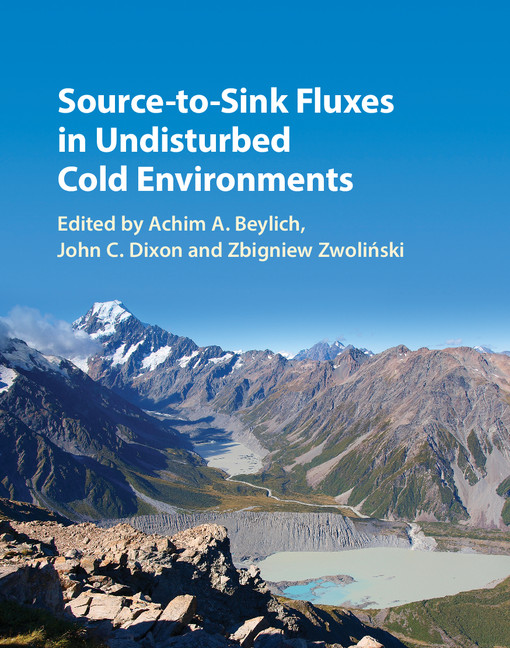SEDIBUD Working Group

WG Chairs:
Dr. Achim A. Beylich
Trondheim (Norway)
Prof. Scott Lamoureux
Kingston (Canada)
Introduction to WG activity
Changes in climate have a major impact on Earth`s surface systems, especially in high-latitude and high-altitude cold environments. Such changes have a major impact on sediment transfer processes. However, until now quantitative analysis of sediment transfers have largely been confined to other climatic zones, therefore a properly integrated study of source-to-sink sediment fluxes in cold environments is long overdue. There is a wide range of high-latitude and high-altitude cold environments that need to be studied, from high arctic/antarctic to subarctic/subantarctic, alpine and upland sites. This provides a great opportunity to investigate relationships between climate, vegetation cover and sedimentary transfer processes across a diverse range of cold environments, with the ability to model the effects of climate change and related vegetation cover adjustments through space-for-time substitution. There is now broad agreement among climatologists that global warming is occurring, the subject of SEDIBUD is therefore of vital interest for the whole world.Climate change affects Earth surface systems all over the world but with arguably the greatest impact in high latitude and high altitude cold environments. In these areas climate change shapes earth surface processes not just by altering vegetation and human activities but also through its impact on frost penetration and duration within the ground surface layers. Climate change also exerts a strong control on cryospheric systems, influencing the nature and extent of glaciers and ice sheets, and the extent and severity of glacial and paraglacial processes. Changes within the cryosphere have major knock-on effects on glacifluvial, aeolian and marine sediment transfer systems. All of these factors influence patterns of erosion, transport and deposition of sediments. However it is a major challenge to develop a better understanding of how these factors combine to affect sedimentary transfer processes and sediment budgets in cold environments. As a starting point our baseline knowledge of the sedimentary transfer processes operating within our current climate and under given vegetation cover, as a basis for predicting the consequences of future climate change and related vegetation cover changes needs to be extended. Only when we have these reliable models will we have fuller understanding. It is therefore necessary to collect and compare data from different cold environments, and use this to assess a range of models and approaches for researching the relationships between climate change, vegetation cover and sediment fluxes.The primary aim of SEDIBUD is to provide an integrated quantitative analysis of sediment transfers, nutrient fluxes and sediment budgets across a range of key cold environments. Such an analysis has so far been lacking. The major focus is on the impact on sediment transfer processes in response to a variety of climate change scenarios at a scale, which incorporates sediment flux processes from source to sink. In order to perform a fully integrated study of source to sink sediment fluxes and sediment budgets in cold environments, SEDIBUD analyse the key components of weathering, chemical denudation, erosion, aeolian processes, mass movements, fluvial transfers/transport, glacial sediment transfers, and sedimentation in lakes and coastal areas. Bringing these different weathering, erosion, transfer and sedimentation processes into one integrated study requires collaboration between a variety of specialists working on the respective subjects. SEDIBUD is bringing together both leading and young scientists in these fields, and creating a unified approach that will take the research forward within the specific focus of climate change impact on the Earth surface. One of the great strengths is the wide variety of scientific fields being harnessed, including physical geography, Quaternary geology, geology, oceanography, limnology, climatology, civil engineering, paleobiology, ecology and biodiversity research. SEDIBUD is also considering the impact of human activity on the environmental sites being studied and how this might relate to climate change. SEDIBUD is able to build on existing and earlier work carried out in the selected key areas, especially in the fields of geomorphology, quaternary geology, ecology and biodiversity research. Indeed the large number of current related research projects highlights the great interest that already exists in this field.
SEDIBUD Steering Committee:
- Dr. Achim A. Beylich (Chair) (Norway)
- Dr. Armelle Decaulne (Secretary) (France)
- Professor John C. Dixon (USA)
- Professor Scott F. Lamoureux (Vice-Chair) (Canada)
- Dr. David Morche (Germany)
- Dr. John F. Orwin (New Zealand)
- Dr. Jan-Christoph Otto (Austria)
- Dr. Irina Overeem (USA)
- Dr. þorsteinn Sæmundsson (Iceland)
- Dr. Jeff Warburton (UK)
- Professor Zbigniew Zwolinski (Poland)
Other Core Members:
- Professor Samuel Etienne (France)
- Professor Bernd Etzelmüller (Norway)
- Professor Jukka Käyhkö (Finland)
- Professor Oliver Korup (Germany)
- Dr. Hugues Lantuit (Germany)
- Professor Karl-Heinz Schmidt (Germany)
- Dr. Ola M. Sæther (Norway)
- Professor Fiona S. Tweed (UK)
- Professor Xiaoping Yang (China)
Invited External Experts:
- Professor Nel Caine (Scotland)
- Professor Ulf Molau (Sweden)
- Professor Lothar Schrott (Germany)
- Professor Olav Slaymaker (Canada)
Activities 2017
Activities 2016
Activities 2015
Activities 2014
Activities 2013
Activities 2012
Activities 2011
Activities 2010
Activities 2009
Activities 2008
Activities 2007
|
NEWS
2st Circular of the 11th SEDIBUD Workshop
–Selected SEDIBUD Key Test Sites –Criteria List and Proposal FCriteria List and Proposal Forms for SEDIBUD Key Test Sites orms for SEDIBUD Key Test Sites *.DOC
|

